#ndpreservation
Text
Well-Meaning Interventions
Here are some frequently encountered DIY repairs that, while well-meaning, are, alas, misguided interventions that exacerbate damage and some alternative approaches that better promote ongoing usability.
While scotch tape is great for wrapping presents and many other tasks, when used on book pages and documents it typically creates problems. The adhesives in clear, pressure-sensitive adhesive tape tend to degrade and discolor over time, resulting in significant damage to the paper. A clear example of degraded tape damage is this 1862 letter from Confederate soldier M.A. Harvey to his wife, “My Dear Eva”.
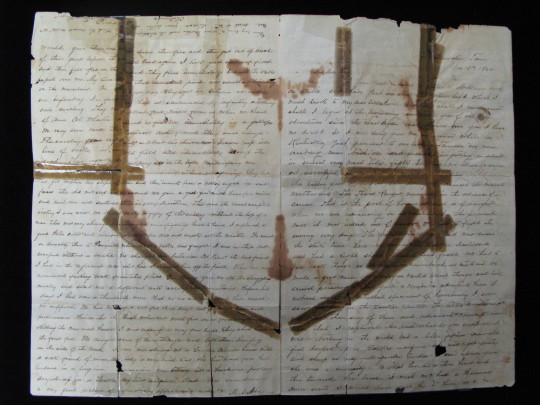
While this letter would have been relatively straightforward to mend with kozo paper and paste, the tape caused permanent damage, and days of work were required to stabilize the letter so that it could be mended appropriately.
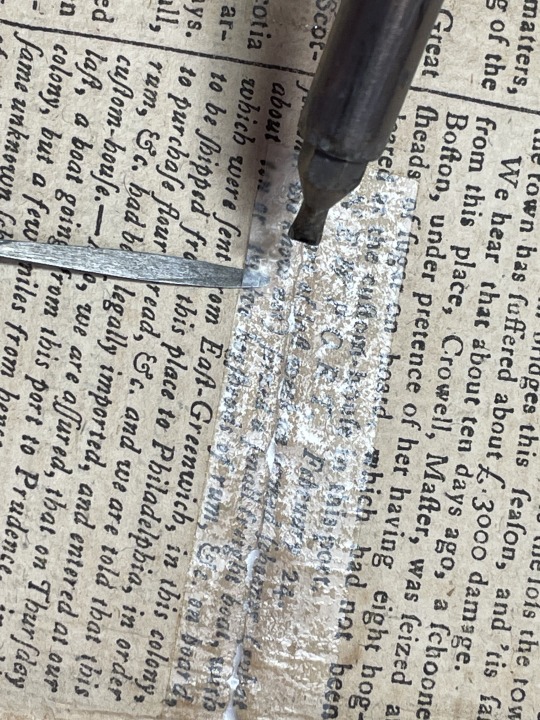
When the boards of a beloved volume become detached, simply applying duct tape to reattach them might seem like a swell solution.
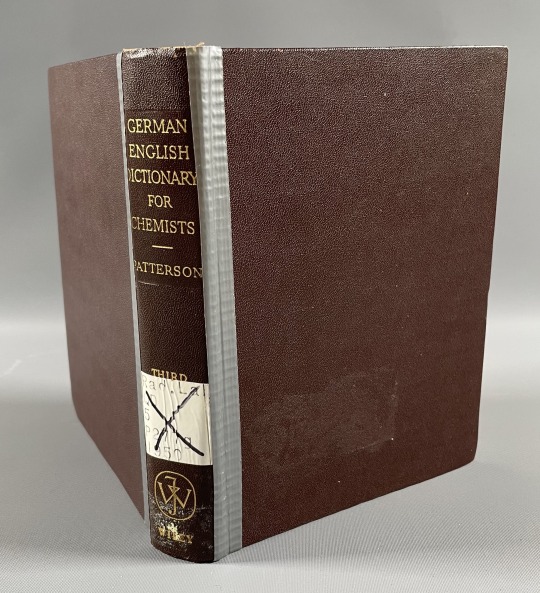
Though duct tape can temporarily reattach book covers, it tends to create significant damage and shorten the book’s lifespan. Similarly, where the spine of a book has become loose or detached, at first glance it might seem that adhering a loose spine covering directly to its text block would be a simple fix.
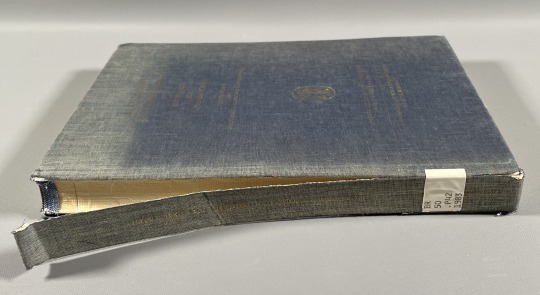
However, the spines of most modern books are not actually glued to the spine of the text by functional design. Adhering the spine covering directly alters the book’s mechanical structure and impedes its functioning, resulting in stress points that create further damage as the book is used.
In order to retain loose book covers or spines, consider tying the book with cotton twill tape, positioning the knot along the head, tail, or fore-edge of the book.

Even better, alkaline book boxes from a preservation supply vendor offer protection from further damage or loss while helping to moderate acidic degradation processes. The repair of books that one wishes to remain functional over time is best left to trained conservators or technicians. For further preservation resources, preservation supply vendors, and information on locating a conservator, see the Hesburgh Libraries Preserving Private Collections guide.
Applying leather dressings such as leather conditioner, neatsfoot oil, or shoe polish to leather books hampers their preservation. While one may enjoy the appearance of polished leather spines in a bookcase, in the short term, leather dressings may darken leather and over time tend to further dry out the skin as well as cause stickiness and/or significant discoloration to the leather, known as leather bloom.
If a leather-bound book is exhibiting signs of leather decay such as red rot (crumbling leather that creates a dusty mess that can transfer to the book pages during use), consider ordering an archival alkaline box for the book or consulting a conservator for further advice on preservation and treatment options.
Using books as a place to “preserve” newspaper clippings, flowers, etc.
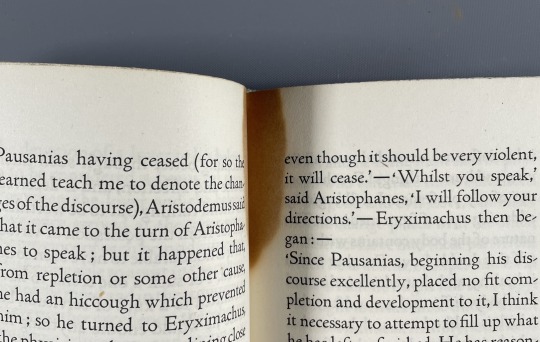
Placing newspaper clippings or other items inside the protective pages of a book might seem like an ideal place to keep the item flat and secure. However, most newspapers are printed on poor-quality paper that quickly becomes highly acidic, and over time this acid will migrate into the pages of the book, chemically degrading and visually staining them. A more effective place to store treasured clippings is within alkaline folders that offer both chemical and physical protection.
828 notes
·
View notes
Text
Our Indispensable Board Shears
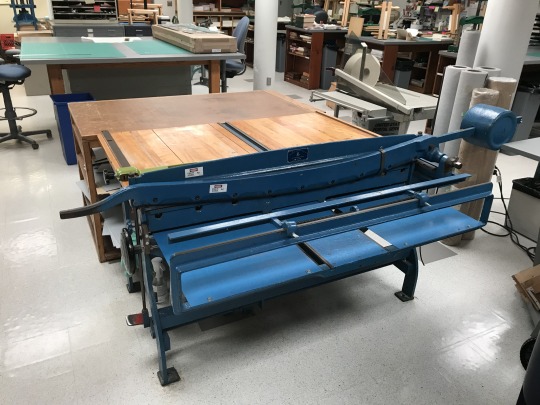
One of the first things you’ll notice in our conservation lab is our giant cutters. These “board shears” are some of our most used tools. We use them to cut a wide range of materials in the process of making protective enclosures, repairing books, and performing various conservation treatments. Both of our shears are Jacques shears, named after their manufacturer, John Jacques & Son of Worcester, Massachusetts. Ours have been modified over the years with wood tops and new paint, but their cast iron supporting structures and steel blades likely date from the late nineteenth or early twentieth centuries.
While they were designed to be used for cutting board or paper by bookbinders, we use them to cut a variety of materials including the PETG (polyethylene terephthalate glycol) plastic that we use to make exhibit cradles for displays of the Hesburgh Libraries’ specialized collections. Our shears have held up well over the decades but sometimes they require specialized adjustments and realignments. Thankfully, through partnerships we’ve developed with machinists in the University’s Physics Department and the generous expertise of conservator Bill Minter, both shears have had helpful adjustments made to them in recent years. For more information on Jacques board shears and their maintenance see Bill Minter’s article Adjusting the Jacques Board Shear.

63 notes
·
View notes
Text
Book Handling and Storage
With proper care, handling, and storage, you can extend the life of your books and preserve them for years of enjoyment. When considering places to house your books, avoid attics, basements, and any other place where humidity and heat can fluctuate wildly. These locations can encourage mold growth, harbor unseen insects and pests, speed up the degradation of acidic paper, and encourage some adhesives used in books to fail. If you wouldn’t be comfortable living in a certain space, neither will your books! Avoid placing your books in bathrooms or kitchens where they will be exposed to increased humidity and water splashes, and avoid locations near radiators and vents where they will be subjected to rapid blasts of heat or cold.
Likewise, while we might like to live with the blinds open and bask in the glow of the afternoon sun, the covers of some books are easily damaged by regular exposure to sunlight and some types of artificial light.

Consider placing your books on shelves in hallways, bedrooms, and other areas where light exposure is minimal and temperature and humidity are controlled.
Store books on shelves off the ground in case of a leak. Avoid shelving books on their fore-edge with their spines facing up as this encourages text blocks to sag and pull away from their covers.

Average-sized books are best stored upright on shelves alongside similarly sized volumes. If a book is too large to be shelved vertically, place it on its side on a separate shelf with similarly sized books. Avoid placing a very tall tome next to a short book as the larger book will not be well supported and can distort and damage smaller books that it is next to and in some scenarios could possibly tip over. Similarly, fill shelves or use bookends to ensure that books are stored snugly upright rather than leaning, as leaning books are subject to distortion and damage.
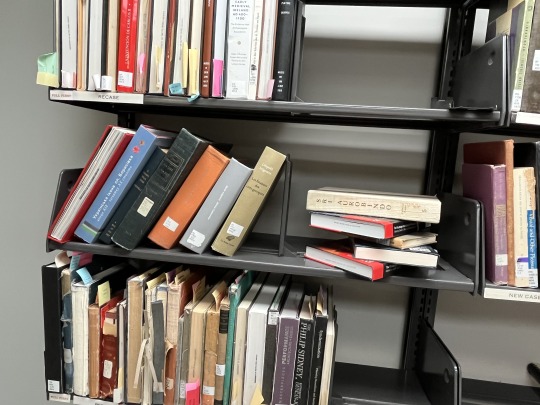
Conversely, avoid packing bookshelves so tightly that force is required when removing them from the shelves, as this too can damage bindings.
When removing books from their shelves, gently grip the spine at the middle of the book (pushing neighboring books backwards slightly as necessary to allow a grip), instead of tugging at the top of the spine, known as the “headcap”, which is especially vulnerable to damage.
Do this:

Not this:
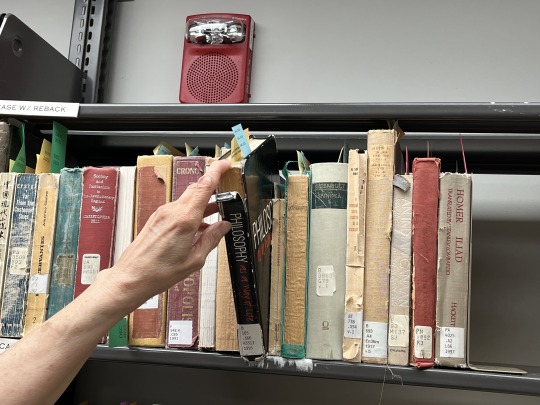
Headcap damage:

Handle books with clean dry hands, avoiding or being especially careful if eating or drinking while handling books. When reading, it is best to cradle books with the hand or support with other props, as many books are not designed to be opened all the way flat to 180° and can suffer stress and damage if forced to open to a wide angle. Avoid “dog-earing" i.e. fold the corners of pages to mark your spot, highlighting, or writing in books that you wish to preserve. Instead use bookmarks to temporarily hold your place and make sure to remove them when finished reading or doing research, especially when using a library book. Sticky notes, paper clips, or rubber bands can all result in damage: paperclips can rust and leave an indentation on the page; sticky notes can leave a residue; and rubber bands can cause tearing of the pages. Transport books safely by limiting the amount you carry by hand. Support them close to your body in order to avoid dropping the books, which can result in significant damage.
When needing to store books in boxes for a prolonged period of time, choose alkaline archival storage boxes as the acid from a common cardboard box creates an acidic micro-environment that promotes acid degradation. Additionally, books should either be packed vertically as they would be on a shelf, flat on their covers, or spine down. As when shelving books, avoid storing them on their fore-edges and avoid stacking flat books on top of vertically oriented books.
68 notes
·
View notes
Text
If it’s good for athletes, it’s good for you

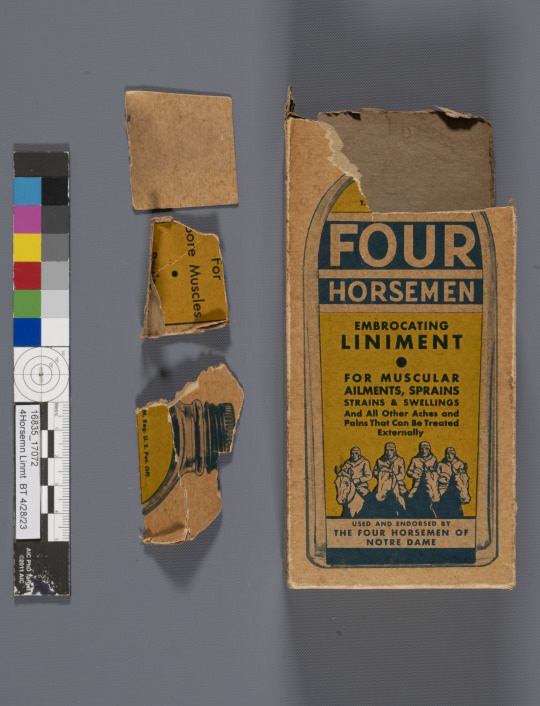
Football is big here at Notre Dame, and we’ve got the archival collections to show for it. Seen here is the Four Horsemen Liniment, a well-branded solution for all muscular ailments, and many other practical uses. Produced in the 1930’s, this bottle maintains its original packaging, as well as some of the liniment itself, posing a unique storage dilemma. The liniment was well preserved in part by a pink rubber balloon wrapped tightly around the bottle cap to prevent leaks (***not a preservation approved strategy***). Treatment involved removal of the balloon using solvents, transporting the liquid contents into a more appropriate lab grade storage container, cleaning residual liniment from the bottle, and constructing a better housing to protect and showcase these unique materials. Kozo paper and wheat starch paste were used to mend the fragmented box, while the accompanying pamphlet which had been stored wrapped tightly around the bottle, was humidified and flattened to reduce its curl. We can’t make any claims to this product’s effectiveness, but as a collection item we think it’s pretty cool.


21 notes
·
View notes
Text
Old Book, New Boards
Following our visit to paper maker extraordinaire Andrea Peterson in the fall (see our November blog post), we were eager to find opportunities to use her handmade papers in our conservation work. Of particular interest was her ABM binders board, which recycles phase box off-cuts to make a delightfully pulpy binders board that is reminiscent of boards used on books throughout the 16th through 19th centuries. Essentially a thick, dense sheet of handmade paper, Andrea’s ABM board is lightweight, alkaline, and comes in a variety of thicknesses that allow for a sympathetic pairing to an older text-block when a new case or binding is necessary.
Hesburgh Libraries recently acquired a c. 15th century manuscript on paper of theological works by Denys the Carthusian. While the manuscript itself dates to the 15th century, it arrived in a much later binding that had broken sewing and very thin detached boards covered in brittle marbled paper.
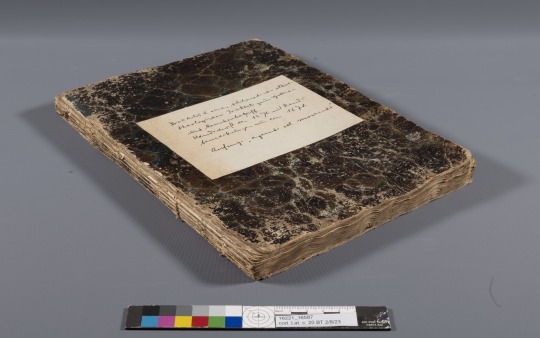
Though we prefer reattaching loose boards where possible, in this case it was determined that splitting or lifting the covering material from these very thin, irregular boards would cause damage. We therefore decided, in collaboration with the curator, that the marble paper covered boards would be retained loose with the manuscript in a cloth-covered clamshell box, and the manuscript would be mended, resewn, and given a new binding.


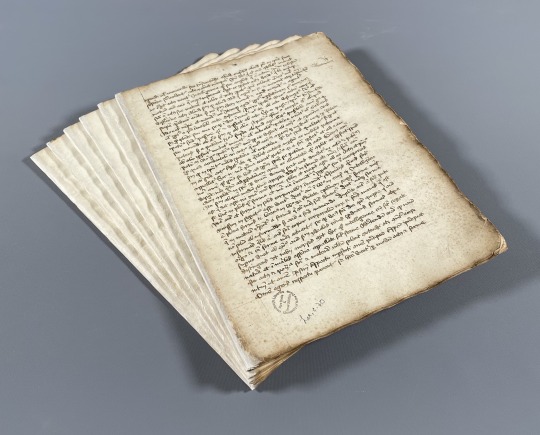
In the process of cleaning and mending the paper in preparation for resewing, a fragment of light blue paper was discovered adhered to one of the inner folios of the manuscript.
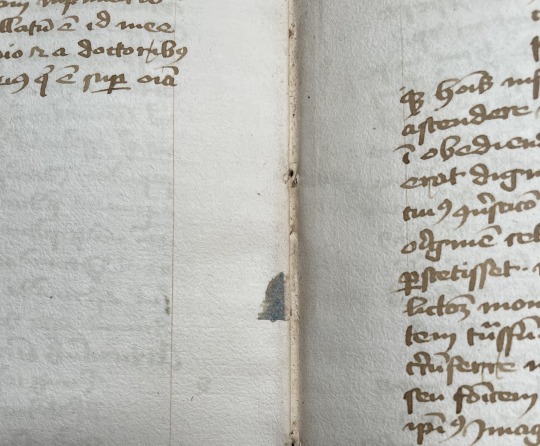
Though it is unclear why and when this paper fragment came to be attached to the manuscript, it is similar to the blue “sugar bag” paper found on many books from the 17th and 18th centuries. In constructing a new case for the manuscript, we used a thin (0.06”) piece of ABM board and covered it with Ruscombe Mills Sesley Sugar Bag handmade laid paper, which closely resembles the fragment of blue paper found inside the manuscript.



Although the new binding does not attempt to be a facsimile of any particular binding, the new case stabilizes the manuscript for use while echoing elements of the manuscript’s history with its thin, textured boards and light blue covering paper.
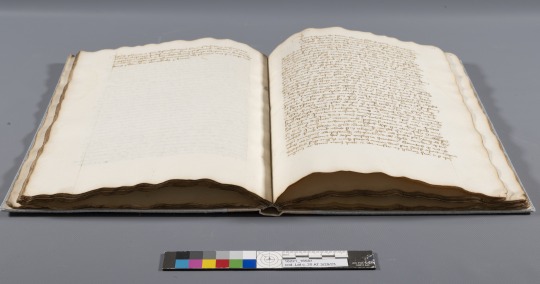

#ndpreservation#conservation#bookconservation#manuscriptmonday#handmadepaper#paperlove#bookbinding#denysthecarthusian#manuscript#rarebooks#NDLibraries
25 notes
·
View notes
Text
Custom Enclosures: Corrugated Boxes
These images represent an extra large oversize book from our Rare Books and Special Collections department. An enclosure was made of corrugated cardboard, which is acid free and buffered, to protect it from environmental changes, dust, light exposure, and handling among other things. The book now lives in its own protective microclimate which reduces degradation of the cover and pages over time.

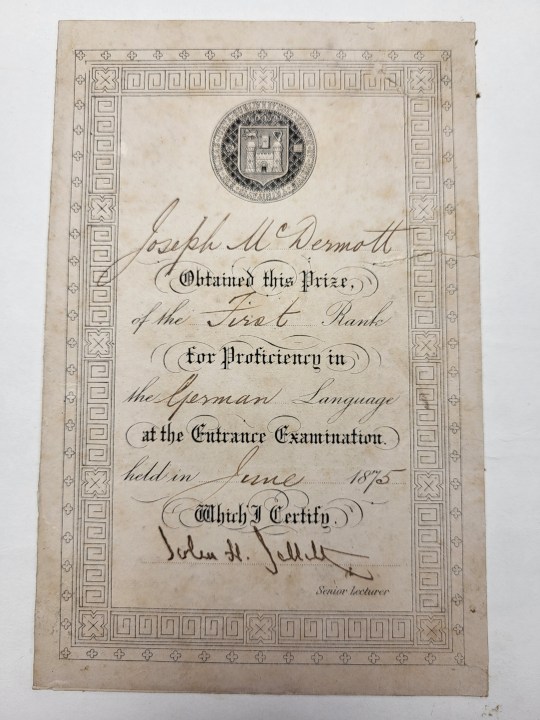
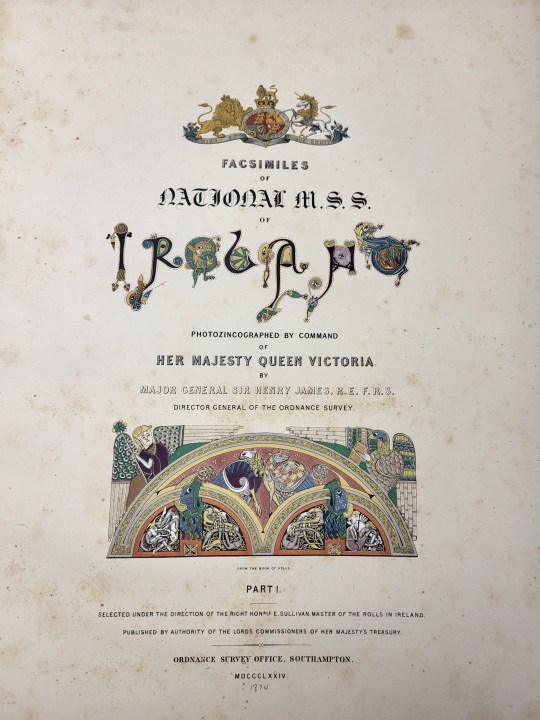

24 notes
·
View notes
Text
The Grand Canal
Preservation staff apply spine labels to circulating collections, and over the years we’ve seen many unique and unusual books, some of which required multiple labels. For instance, this accordion book, “Grand Canal'' by Laurent Dequick, illustrates the entire landscape of the Grand Canal located in Venice, Italy. One side shows the west view from the river, and on the flip side is the east view. The book and its box both received a call number label.
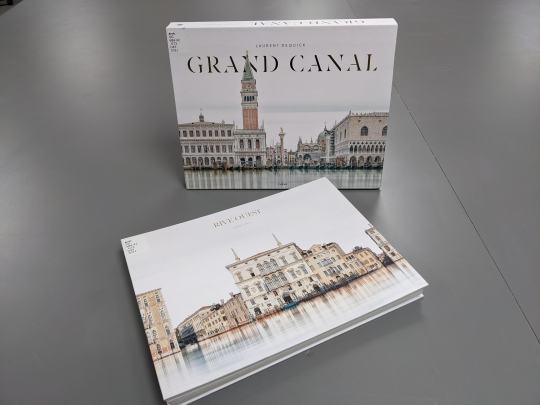
17 notes
·
View notes
Text
Moving to Re-Usable Modular Cradles for Exhibits
Following her attendance at an AIC workshop, in May 2022, led by Alessandro Scola—Senior Book Conservator at Sheridan Libraries, Johns Hopkins University—our former Gladys Brooks Conservation Fellow, Maren Rozumalski, conducted a cradle-making training session here at our lab, based on what she had learned about Mr. Scola’s system of fashioning modular and reusable cradles. She left us with an excellent set of instructions, templates, and tools afterward.
In the Fall of 2022, we built up a ‘fleet’ of bases of different sizes and display angles. For the recently mounted Hesburgh Libraries, Rare Books & Special Collections Spring 2023 exhibit on Irish Book Arts, we began using the new cradles for the first time. The cradles are made using lightweight and pliable PETG plastic. We have been pleasantly surprised by their overall sturdiness and the variety of book sizes and formats that they can support.
Not only will the reusable bases save us production time in preparing for future exhibits, having at least half of the structure already made each time we begin to construct a cradle will mean using less plastic for the one-time use custom pieces that will be necessary, which will have a positive impact on our budget and also the environment since there will be less plastic discarded per exhibit.
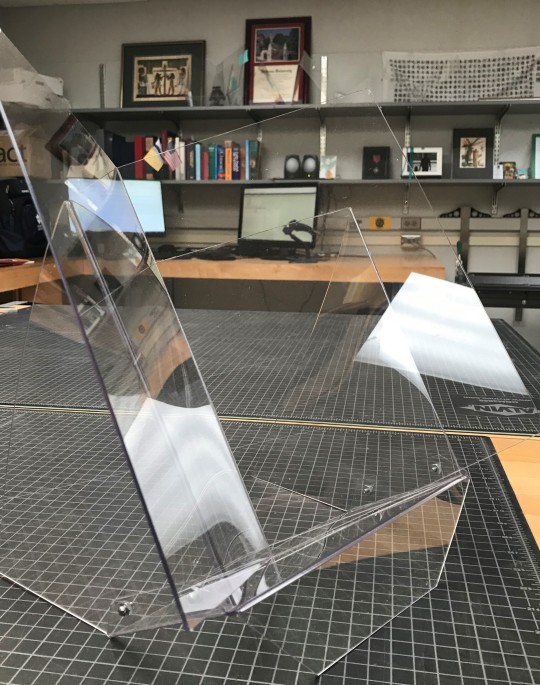
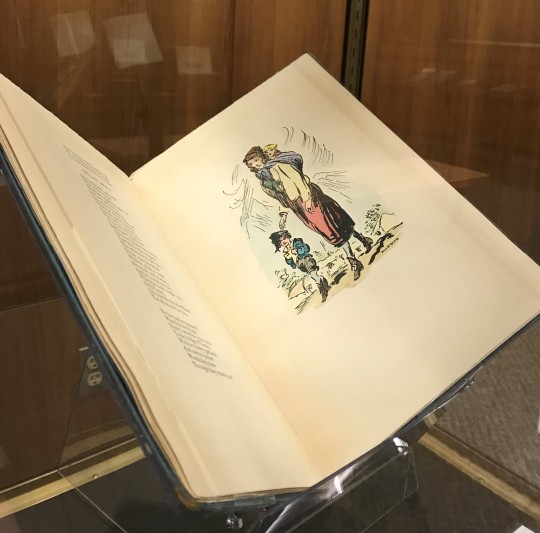
26 notes
·
View notes
Text
Pokagon Student Visit
The conservation lab was recently graced by a visit from a highly engaged group of students from Michigan. A collaboration between the Pokagon Band of Potawatomi, the University of Notre Dame, and the U.S. Army, the students were part of a physics summer camp that included field trips to expose them to potential STEM-related careers. The students had so many great questions and astute observations! We really enjoyed sharing and discussing our work to preserve collections with them.


#ndpreservation#ndrarebooks#conservation#preservation#pokegnek#pokagon#potawatomi#nativenationsyouthcouncil#physics#STEM
8 notes
·
View notes
Text
Protecting a Paste Paper Binding
Paste papers are one of the earliest types of decorative paper. From the late 16th to the 18th century, these relatively easy to make decorative papers were often made and used by bookbinders as book covering material and endsheets.
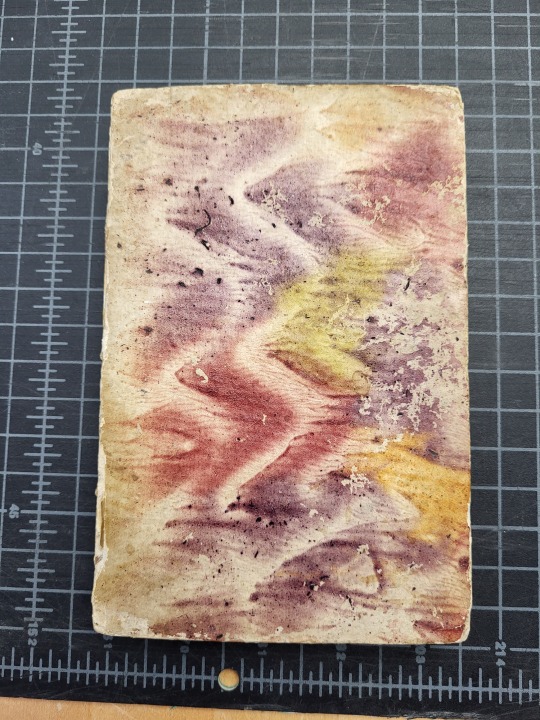
The example shown here has suffered some damage especially along the spine.

In order to protect it from further damage we have placed it into a four-flap enclosure also known as a “tuxedo” box. We typically use “tux” boxes for small, lightweight items that are ¼” to 1” thick. Made with alkaline 20 point card stock, these enclosures take less than 20 minutes to make and are custom cut and folded to fit the book’s exact dimensions. This lightweight and quick-to-make design offers excellent protection for lightweight books.


19 notes
·
View notes
Text
Water Leak: Hesburgh Library Lower Level
Recently a bit of water from cleaning equipment on the first floor of the library made its way through a crack in the floor over the political science reference collection in the lower level. Fortunately the leak was identified early by shelving staff, who quickly draped plastic sheeting over the impacted shelvesing to contain the damage. Of the forty-six affected books, thirty-two were only minimally impacted and able to be wiped dry with a cloth while the remaining fourteen suffered significant water damage that required drying treatments. Several books were fanned open to dry while others were interleaved with absorbent sheets and placed under weights to speed drying. The wettest books benefited significantly from interleaving with Zorbix sheets, a commercially available product that is reusable, highly absorbent, and quick drying.

Books fanned out to air dry.

Flattening pages under weight.

Zorbix sheet after absorbing water.
12 notes
·
View notes
Text
Meet Our Student Assistants

Claire Bosch is from Western Springs, Illinois. She is currently working towards a Bachelor of Arts degree in History with a minor in Theology. Claire applies her past experience working at the Snite Museum by demonstrating her knowledge of safeguarding and preserving our one-of-a-kind collections. She exhibits an exceptional level of manual dexterity and a commitment to precision and thoroughness. Claire’s accuracy is critical in the process of measuring and creating customized enclosures for various-sized books. She designs clamshell and “tuxedo” style boxes as demonstrated in the picture above. Claire fabricates mylar jackets that are tailored to protect rare volumes. She has recently learned how to preserve specialized collections by using deacidification spray to slow the process of future deterioration.
Thanks to all of our students for being a valuable part of our preservation team!
8 notes
·
View notes
Text
Meet Our Student Assistants

Irina Stanescu is from Morgantown, West Virginia. Irina is a freshman architectural student with a keen eye for detail who is pursuing her bachelor’s degree. Irina spends her free time outside the lab swimming with our Notre Dame swim team. She is a natural at conservation work, in my opinion! Even though this is her first experience with conservation work, she executes each treatment flawlessly with minimal training. Irina began in the lab by stapling and sewing music scores into protective binders and constructing pockets for the score’s various instrument parts. She then learned customized book jacketing using our Colibri machine. This machine seals a clear polyethylene jacket onto the book to help protect the cover. She is currently re-backing books with damaged spines which you can see in the image above. Irina recently assisted in the construction of several "tuxedo" style boxes to preserve a large Asian collection.
8 notes
·
View notes
Text
Preserving vulnerable historic photographic images on cellulose nitrate

After nearly two years of collaborative research and planning, the Hesburgh Libraries’ remaining cellulose nitrate negative photographs have landed safely at the digitization vendor.
Cellulose nitrate was the first plastic film. It was invented in the mid 19th century and around 1890 an application for use as a photographic film substrate was developed. Cellulose nitrate remained in use as a photographic film base as late as the 1940s, well after it was known to be especially prone to degradation and flammability. Reel to reel films are the most vulnerable, since they consist of a densely packed mass of cellulose nitrate that is often stored in a tightly fitting can that inadvertently traps gaseous byproducts and autocatalyzes—speeds up—the degradation process, and the heat generated from running films through film projectors has even sparked a number of major theater fires—see Cinema Paradiso (1988) for an engaging film portrayal of this disastrous consequence.
Gratefully, the Hesburgh Libraries’ cellulose nitrate reel to reel films were transferred to a national preservation film vault decades ago. While individual cellulose nitrate negative photographs pose considerably less risk than nitrate film reels, especially when housed in quality folders and boxes, and stored in cooler temperature conditions, the Hesburgh Libraries recently deemed it prudent to survey photographic collections in order to identify remaining cellulose nitrate holdings, assess their condition, and devise a solution to preserve the images in adherence with NFPA 40, the National Fire Protection Association’s Standard for the Storage and Handling of Cellulose Nitrate Film. After much consideration of risks and benefits, the Libraries decided to preserve these images digitally. A digitization vendor with nitrate film experience was secured, and with the help of campus Risk Management and the digitization vendor, plans for shipping and subsequently disposing of the film in accordance with federal regulations were devised.
11 notes
·
View notes
Text
Meet Our Student Assistants

Macey Bartels is from Allentown, New Jersey. She is a second-year student majoring in Art History with minors in Middle Eastern and Russian studies. Macey came to us because she is passionate about studying art and is interested in pursuing conservation work for museums. This is her first year learning about preservation and the art of conservation. She brings to our lab her experience working as a museum assistant, her training in both classical and modern art forms, and her meticulous attention to detail. Macey began with learning end sheet preparation for case bindings and quickly progressed to making custom enclosures. She has become highly skilled at creating corrugated clamshell style boxes to preserve fragile books. Because of her significant interest in conservation, we have advanced Macey to text block preparation, and she is currently working on constructing new cases for severely damaged collections as seen in the image above.
7 notes
·
View notes
Text
Meet Our Student Assistants

Gautier Tonongbe is from Cotonou, Benin. He is currently in his first year of graduate school, pursuing an MBA in Business, Finance. Gautier is adding to his vast list of accomplishments by working for the first time in a conservation lab and learning a variety of new skills. He always has a smile on his face and, like any true businessman, immediately makes friends with every member of our crew. Gautier started by learning how to safeguard pamphlets by placing them into protective binders. His precise hand skills are shown in the image above as Gautier creates “tuxedo” style boxes used to protect brittle books that are part of a large collection of Asian materials. He has also learned how to use our Colibri machine to build customized polyethylene jackets for our collections. These jackets shield the covers from the weather and maintain their integrity. Gautier is currently learning how to repair torn and loose pages using wheat starch paste and Japanese Uso Mino paper.
12 notes
·
View notes